I’m two cities and 1,500 miles from where I last wrote–I’m in Yunnan, nicely named “South of the Clouds.”
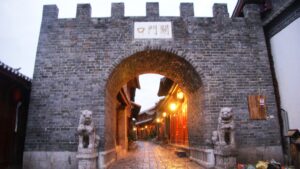 If Qingdao (or as I prefer, Tsingtao) was fun to wander aimlessly because it was a German Colony, my next city, Lijiang, was fun to wander around aimlessly because it was back in China–or rather, because it wasn’t “Chinese.”
If Qingdao (or as I prefer, Tsingtao) was fun to wander aimlessly because it was a German Colony, my next city, Lijiang, was fun to wander around aimlessly because it was back in China–or rather, because it wasn’t “Chinese.”
Yunnan was the place you fled when the dominant Han Chinese came through, or where you were banished if the Emperor didn’t really like you,  but did not want to kill you. That’s how the Naxi people, among others, wound up in Lijiang, a city also known as “Shangri La.” At nearly 8,000 feet, it had the cool evenings and splendid scenery that draws Americans (and others) to the Rockies. Because “the hills were high, the ocean vast, and the emperor far away,” it drew the Naxi nationality (one of some 40 or so that give Yunnan a unique flavor). The old city was pretty well devastated in an earthquake in 1996, but in rebuilding it, the Chinese created a world heritage site, because the Naxi
but did not want to kill you. That’s how the Naxi people, among others, wound up in Lijiang, a city also known as “Shangri La.” At nearly 8,000 feet, it had the cool evenings and splendid scenery that draws Americans (and others) to the Rockies. Because “the hills were high, the ocean vast, and the emperor far away,” it drew the Naxi nationality (one of some 40 or so that give Yunnan a unique flavor). The old city was pretty well devastated in an earthquake in 1996, but in rebuilding it, the Chinese created a world heritage site, because the Naxi 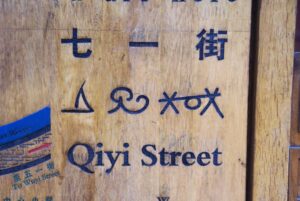 have a pictograph language that they still use, and a unique architectural style that has made Lijiang the mecca for trekkers and tourists that it once was when it was a trading post on the “old horse road.” The Naxi nationality (that’s how the Chinese refer to their minorities) number around 300,000, and seem to peacefully coexist with the Chinese. As my guide (a Naxi but also a member of the Communist Party put it), “we embraced many of the Han things and became civilized.”
have a pictograph language that they still use, and a unique architectural style that has made Lijiang the mecca for trekkers and tourists that it once was when it was a trading post on the “old horse road.” The Naxi nationality (that’s how the Chinese refer to their minorities) number around 300,000, and seem to peacefully coexist with the Chinese. As my guide (a Naxi but also a member of the Communist Party put it), “we embraced many of the Han things and became civilized.”
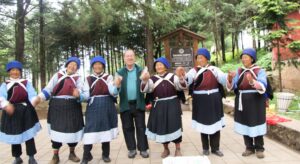 One of the sights I insisted on seeing was a “red hat” monastery. Not just the Naxi nationality got driven out of central China, but apparently the Tibetan “losers” got driven out as well. The “yellow hats” predominate in Lhasa–but there are a number of “red hat” monasteries in Lijiang area. Hence, many of the buildings have a Tibetan influence, a Naxi influence, and a Han influence.
One of the sights I insisted on seeing was a “red hat” monastery. Not just the Naxi nationality got driven out of central China, but apparently the Tibetan “losers” got driven out as well. The “yellow hats” predominate in Lhasa–but there are a number of “red hat” monasteries in Lijiang area. Hence, many of the buildings have a Tibetan influence, a Naxi influence, and a Han influence.
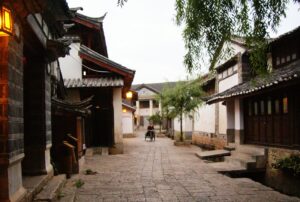 I stayed in a new building (old style) in the old city, which has a confusing maze of cobblestone streets (no cars, which is a blessing in China!), and got up early (the sun is at least an hour later here than in Beijing, but China is ALL one time zone), and wandered around taking pictures with no tourists in them. The hotel (and this may indicate the time warp) had a magazine touting its well-known visitors, including “Comrade Hu Jin-tao,” the first time in years I’ve heard anyone refer to anyone in China as comrade!
I stayed in a new building (old style) in the old city, which has a confusing maze of cobblestone streets (no cars, which is a blessing in China!), and got up early (the sun is at least an hour later here than in Beijing, but China is ALL one time zone), and wandered around taking pictures with no tourists in them. The hotel (and this may indicate the time warp) had a magazine touting its well-known visitors, including “Comrade Hu Jin-tao,” the first time in years I’ve heard anyone refer to anyone in China as comrade!
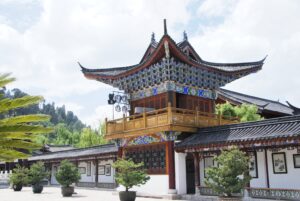 The centerpiece of the city is the home of the “local king,” the Mu family, which looks for all the world like a small version of the Forbidden C ity. Which means, I think, that it’s always glorious to be rich.
The centerpiece of the city is the home of the “local king,” the Mu family, which looks for all the world like a small version of the Forbidden C ity. Which means, I think, that it’s always glorious to be rich.
The Naxi also practice their own 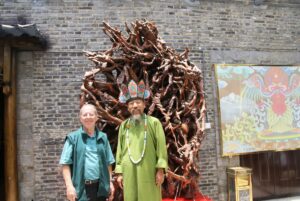
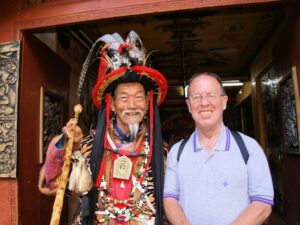 religion, the Dongba, which is based on wisdom and age (I could be a Dongba). There are 9 Dongba shamans, who are the most wonderfully photogenic people I’ve met in China.
religion, the Dongba, which is based on wisdom and age (I could be a Dongba). There are 9 Dongba shamans, who are the most wonderfully photogenic people I’ve met in China.
From 8,000 feet, I flew an hour south, into the subtropics of Xishuangbanna, or Ban Na as it’s known. It’s nestled into the intersection of Thailand, Laos, and Burma–and contains rain forest, which is where I’m going today.
My guide, Chang Le, has the best English of any guide I’ve had on this trip. When I asked him about himself, he told me that he came here on vacation, and never wanted to go home.
I expect to enjoy the place, but not that much!!!!